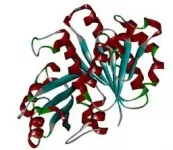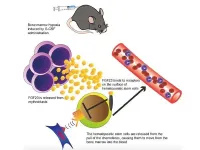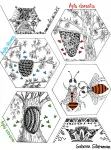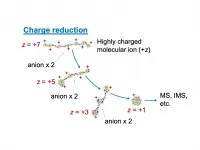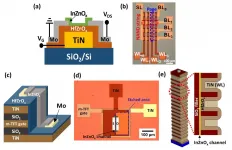Healing ceramic electrolyte degraded by Li dendrite
Post-annealing effect for healing Li garnet solid electrolyte degraded by Li dendrite penetration
2021-01-19
(Press-News.org) Overview:
A research team in the Department of Electrical and Electronic Information Engineering at Toyohashi University of Technology and the Department of Chemistry at University of Calgary has investigated the effect of post-annealing for healing Li garnet solid electrolyte degraded by the growth of Li dendrites. The ionic conductivity of the annealed solid electrolyte was slightly lower than that of the electrolyte before annealing but was retained above 10?4 S cm?1 at room temperature. The electrochemical results obtained indicate the possibility of reusing the solid electrolyte degraded by the growth of Li dendrites in another all-solid-state Li battery.
Details:
A research team in the Department of Electrical and Electronic Information Engineering at Toyohashi University of Technology and the Department of Chemistry at University of Calgary has investigated the effect of post-annealing for healing Li garnet solid electrolyte degraded by the growth of Li dendrites. The ionic conductivity of the annealed solid electrolyte was slightly lower than that of the electrolyte before annealing but was retained well above 10?4 S cm?1 at room temperature. The electrochemical results obtained indicate the possibility of reusing the solid electrolyte degraded by the growth of Li dendrites in another all-solid-state Li battery. The results of their research have been published in ACS Applied Energy Materials on December 7, 2020.
The development of solid inorganic lithium-ion conducting materials for utilization as solid electrolytes is crucial for the development of highly safe and reliable next-generation all-solid-state lithium (Li) batteries. Among various oxide-based solid electrolyte materials, a garnet-type oxide with the formula of Li7La3Zr2O12 (LLZO) has attracted considerable attention because of its high Li-ion conductivity at room temperature, excellent thermal performance, and high stability against Li metal.
Although the use of Li metal with large gravimetric theoretical capacity (=3,860 mAh g?1) and the lowest redox potential as a negative electrode leads to the high energy density of batteries, the formation of a solid?solid interface between LLZO and the Li metal electrode is a major drawback. Poor interfacial connection causes non-uniform Li plating and intergranular penetration of Li dendrite in polycrystalline LLZO. This effect is prominent when the battery is cycled particularly at high current densities, resulting in an internal short-circuit failure.
Certainly, the establishment of prevention technology for short-circuit failures is widely researched for the development of all-solid-state batteries with Li metal as a negative electrode. Conversely, from the viewpoint of effective use of material resources, the possibility of reusing LLZO extracted from a solid-state battery after the occurrence of a short-circuit failure is worth considering. If the amount of Li dendrite propagating in LLZO is small and the short-circuit area is highly localized, LLZO may be reused by removing the Li dendrite therein.
For the first time, a research team in the Department of Electrical and Electronic Information Engineering at Toyohashi University of Technology and the Department of Chemistry at University of Calgary has investigated the reusability of a garnet-type Ta-substituted LLZO (Ta-LLZO) ceramic solid electrolyte shorted or degraded by Li metal penetration during electrochemical Li plating/stripping testing for a Li/Ta-LLZO/Li symmetric cell.
Ta-LLZO was removed from a tested cell after the degradation via Li dendrite penetration had occurred and then Li metal electrodes attached with Ta- LLZO were removed in ethanol. After that, Ta-LLZO was annealed in air at 800-900 ºC for several hours. It was confirmed that annealed Ta-LLZO shows slightly lower Li ion conductivity compared with that of as-prepared one but maintains the conductivity well above 10?4 S cm?1 at room temperature. The slight decrease in the conductivity of annealed Ta-LLZO is mainly attributed to the formation of impurity phases and structural changes near the end surface of Ta-LLZO, and the degree of degradation depends on the area size for Li dendrite penetration. Furthermore, Li plating/stripping in another symmetric cell with annealed Ta-LLZO can be performed.
The research team believes that the degradation of Li-ion conductivity in annealed LLZO can be mitigated further by optimizing the post-annealing condition, and the results obtained can be used as fundamental information towards the reuse of shorted-circuited or degraded LLZO as solid electrolyte in another solid state Li battery.
INFORMATION:
Reference:
Ryoji Inada, Atsuto Takeda, Yusuke Yamazaki, Shotaro Miyake, Yoji Sakurai and Venkataraman Thangadurai, Effect of Postannealing on the Properties of a Ta-Doped Li7La3Zr2O12 Solid Electrolyte Degraded by Li Dendrite Penetration, ACS Applied Energy Materials 3 (2020) 12517-12524. DOI: 10.1021/acsaem.0c02474
Link to corresponding researchers:
Ryoji Inada, Associated Professor in Toyohashi University of Technology
https://www.tut.ac.jp/english/schools/faculty/ee/141.html
Venkataraman Thangadurai, Professor in University of Calgary
https://ucalgary.ca/thangadurai-group
This work was partly supported by Grant-in-Aid for Scientific Research (JSPS KAKENHI) with Grant Numbers 16KK0127 (Fund for the Promotion of Joint International Research (Fostering Joint International Research (A)) and 19H02128 (Fundamental Research (B)) from the Japan Society for the Promotion of Science (JSPS).
[Attachments] See images for this press release:
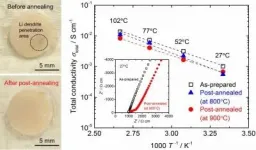
ELSE PRESS RELEASES FROM THIS DATE:
2021-01-19
Overview:
The research team of the Department of Computer Science and Engineering at the Toyohashi University of Technology and the Institute of Food Biotechnology and Genomics at the National Academy of Sciences of Ukraine have proposed a new drug to treat tuberculosis (TB), utilizing the state-of-the-art molecular simulations. This drug may inhibit the cell division of Mycobacterium tuberculosis (M. tuberculosis) and suppress its growth. In addition, because this drug acts on the enzymes secreted by M. tuberculosis instead of acting on M. tuberculosis itself, M. tuberculosis ...
2021-01-19
"The real voyage of discovery consists not in seeking new landscapes, but in having new eyes."
Scientists would vouch for this statement because scientific pursuit has the habit of offering chance discoveries if we think about things differently.
In the lab of Arati Ramesh at the NCBS, the team loves to spy on the structure and sequence of Ribonucleic acids (RNAs; molecules that decrypt an organism's genetic code into protein messages). During one such instance, graduate students in Arati's lab were peering at a family of nickel and cobalt (NiCo RNAs) sensing bacterial RNAs that have a clover leaf-like structure. ...
2021-01-19
A Kobe University research group including graduate student ISHII Shinichi and Associate Professor KATAYAMA Yoshio (both of the Department of Hematology, Graduate School of Medicine) have discovered that fibroblast growth factor-23 (FGF23) produced by erythroblasts (cells that are the precursors of red blood cells) promotes the movement (mobilization) of hematopoietic stem cells (*1) into the peripheral blood. Up until now, FGF23 has been known for the role it plays in the kidneys as a hormone which regulates phosphate concentrations throughout the body.
It is hoped that this discovery will enable new strategies to be developed for harvesting hematopoietic ...
2021-01-19
It is early in the morning. Ebi and his colleagues try not to twitch as they stare intently at a rectangular box filled with sugary treats. These aren't for them, but for the honey bees that they study. The tiny buzzers toggle between the sugar 'feeder' and the hive, which are a few metres apart. Interestingly, the bees that visit the feeder aren't secretive about this new found food source. They graciously advertise its location to their nest mates and over time more bees are seen buzzing to the feeder.
This behavior has been observed and researched for decades; but still, the question of how bees communicate within the noisy quarters ...
2021-01-19
Mass spectrometers (MS) have become essential tools in chemistry and biology laboratories. The ability to quickly identify the chemical components in a sample allows them to take part in a diverse array of experiments, including radiocarbon dating, protein analysis, and monitoring drug metabolism.
MS instruments work by giving the analyte molecules an electric charge, and shooting them through a region of space with a uniform electric field, which curves their trajectory into a circle. The radius of the circle, which depends on the ratio of the molecule's mass to its charge, is detected and compared with known samples. Because the method can only measure this ratio, not the mass itself, excess charges can lead to inaccurate or ambiguous results.
Now, a team of researchers lead ...
2021-01-19
"Stripy zebra, spotty leopard, ...". Kids never become bored pinpointing animals based on their unique body patterns. While it is fascinating that living creatures develop distinct patterns on their skin, what may be even more mysterious is their striking similarity to the skin of frozen liquid metals.
Pattern formation is a classic example of one of nature's wonders that scientists have pondered for centuries. Around 1952, the famous mathematician Alan Turing (father of modern computers) came up with a conceptual model to explain the pattern formation process of a two-substance system. Such patterns are also called Turing patterns thereafter.
Pattern formation is also commonly adopted by manmade systems and this is especially true in the ...
2021-01-19
Fungi are among the world's oldest and most tenacious organisms. They are now showing great promise to become one of the most useful materials for producing textiles, gadgets and other construction materials. The joint research venture undertaken by the University of the West of England, Bristol, the U.K. (UWE Bristol) and collaborators from Mogu S.r.l., Italy, Istituto Italiano di Tecnologia, Torino, Italy and the Faculty of Computer Science, Multimedia and Telecommunications of the Universitat Oberta de Catalunya (UOC) has demonstrated that fungi possess ...
2021-01-19
The compulsory collection of DNA being undertaken in some parts of the world is not just unethical, but risks affecting people's willingness to donate biological samples and thus contribute to the advancement of medical knowledge and the development of new treatments, says a paper in the European Journal of Human Genetics, published online* today [18 January 2021].
Citing abuses being carried out in China, Thailand, and on the US/Mexico border, the authors1 call on scientific journals to reexamine all published papers based on databases that do not meet accepted standards of ethical approval, and demand an end to collaborations between academic institutions worldwide and those in countries carrying out unethical DNA collections. ...
2021-01-19
As we enter the era of superintelligence and hyper-connected Fourth Industrial Revolution, the importance of high-density and high-performance memory is greater than ever. Currently, the most widely used NAND flash memory has issues of high power consumption, slow operation speed, and vulnerability to repetitive use since it relies on the charge trap effect to store information. To this, a POSTECH research team has recently demonstrated a ferroelectric memory that exceedingly surpasses the performance of the conventional flash memory in terms of operation speed, power consumption, and device reliability.
A POSTECH research team - led by Professor Jang-Sik Lee, and Ph.D. candidates Min-Kyu Kim and Ik-Jyae Kim of the Department ...
2021-01-19
Maxwell equations govern the evolution of electromagnetic fields with light being a particular solution of these equations in spaces devoid of electric charge. A new study published in EPJ C by Alexei Morozov and Nikita Tselousov, from the Moscow Institute of Physics and Technology and the Institute of Transmission Problems, Russia, respectively, details peculiar solutions to the Maxwell equations--so-called Maxwell knots. The research could have applications in the fields of mathematical physics and string theory.
"We usually think of light as the plane waves. It was a breakthrough when ...
LAST 30 PRESS RELEASES:
[Press-News.org] Healing ceramic electrolyte degraded by Li dendrite
Post-annealing effect for healing Li garnet solid electrolyte degraded by Li dendrite penetration

